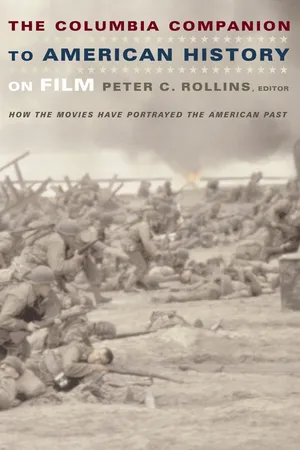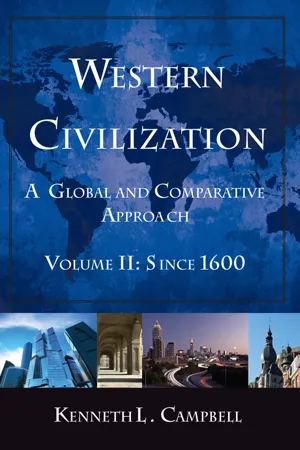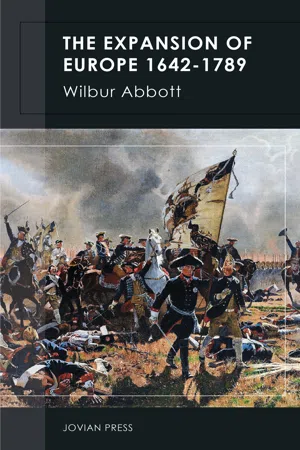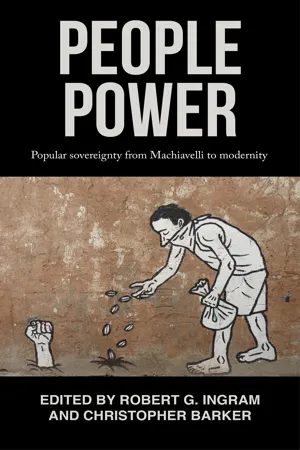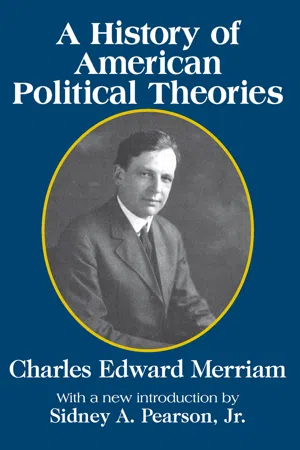History
The American Revolution
The American Revolution was a pivotal period in the late 18th century when the thirteen American colonies sought independence from British rule. It was marked by significant events such as the Boston Tea Party, the signing of the Declaration of Independence, and the military conflicts that ultimately led to the formation of the United States of America as a sovereign nation.
Written by Perlego with AI-assistance
Related key terms
7 Key excerpts on "The American Revolution"
- eBook - ePub
The Columbia Companion to American History on Film
How the Movies Have Portrayed the American Past
- Peter Rollins(Author)
- 2004(Publication Date)
- Columbia University Press(Publisher)
Given this conception of The American Revolution, the scarcity of films treating it should come as little surprise. The revolution featured few dramatic events of the type Wood mentions—riots, conflagrations, executions—little of the chaotic, compelling imagery, in other words, in which the French and Russian revolutions abounded. It may be objected here that The American Revolution was, nonetheless, a war, and that military events have been vividly represented onscreen. There are differences, however, between narratives of war and those of revolution, and the military aspects of The American Revolution, despite their importance, did not define the event in any essential way. Instead, what distinguishes the era was the production and recognition of a new political ideology. According to Bernard Bailyn, the revolutionaries’ aims and grievances stemmed from the perceived suspension of rights guaranteed them by the British constitution. They sought “not the overthrow or even the alteration of the existing social order but the preservation of political liberty threatened by the apparent corruption of the constitution, and the establishment in principle of the existing conditions of liberty. . . . What was essentially involved in The American Revolution was not the disruption of society, with all the fear, despair, and hatred that that entails” (19).Bailyn asserts the primary causes of the revolution to be ideals, not social discontent or tyranny. To make the point that The American Revolution was fundamentally a revolution of ideology and of language—communicating new understandings of social class, political power, and identity—in no way diminishes its significance. The preeminence of language, however, seems to have presented obstacles to constructing strong films.Wood describes the popular notion of The American Revolution as a musty museum exhibit, a place one visits to gaze at the documents under glass and pay homage to the “Founding Fathers” whose faces grace our money. This presentation of history is more conducive to genuflection than fascination. One reason for this conception may be that the revolution has too often been interpreted in mythic and moralistic terms, as a narrative of men and women of unassailable character and vision inhabiting a utopia of American righteousness in conflict with British tyranny. This view tends to turn the era into a ready-made symbol of all that was right with America, a symbol generally used by those who assert that a great deal is currently wrong. - eBook - ePub
Western Civilization: A Global and Comparative Approach
Volume II: Since 1600
- Kenneth L. Campbell(Author)
- 2015(Publication Date)
- Routledge(Publisher)
4The Age of Revolution in France and the Americas, 1775–1815
In the last quarter of the eighteenth century, revolutionaries in Britain’s American colonies and then in France attempted to apply the ideas of the Enlightenment in order to bring about political change. They succeeded. In America, the severing of the colonies’ alliance with Great Britain led to a republican form of government—a radical notion in the eighteenth century. The French revolutionaries ended up abolishing a monarchy that had endured for over a thousand years and experimenting with a number of new forms of government. They also went much further than their American counterparts in attempting to enact social reform. Their ideas and actions reverberated throughout Europe and, eventually, the world. People were either inspired or terrified by the French Revolution. Napoleon Bonaparte, who emerged as the leader of a new French empire, exported the revolution and made the fears of many a reality at the same time that the spread of French ideas created new adherents outside of France. For the French proclaimed not merely the rights of Frenchmen, but the rights of all men. Each country and people impacted by the French Revolution responded in a unique way relative to their particular circumstances. For example, the Revolution attracted greater sympathy in the urbanized areas of the Low Countries, Switzerland, western Germany, and Italy than in the more agrarian regions of Spain, Eastern Europe, Russia, and the Balkans.The British colonies in North America established an important precedent for their Latin American counterparts when they successfully declared and then won their independence from Great Britain. The North American colonists had tired of the taxes imposed on them from abroad without their own consent. They resented the economic regulations that subordinated the interests of the colonists to those of the mother country. They believed that they could govern themselves and they adopted the ideals of the Enlightenment, which they incorporated into their Declaration of Independence. The same factors influenced the residents of Spain’s colonies in the Americas to participate in colonial revolts by the late eighteenth century. Whatever the benefits of the economic reforms that Britain tried to impose on North America, they led to a political disaster. The same could be said for the Spanish reforms of the eighteenth century in Latin America. Inspired by the ideals of the American and French Revolutions, Latin American colonies began to declare their independence from Spain and Portugal in the early nineteenth century. - eBook - ePub
- Wilbur Abbott(Author)
- 2017(Publication Date)
- Jovian Press(Publisher)
The American Revolution. 1768-1783
..................THE FOCUS OF THE GREAT revolutionary movement which was sweeping through every department of European life in the seventh decade of the eighteenth century was the British Empire. There, for the moment, was every element of the forces then altering the world to be found in its most significant form. There the Industrial Revolution had begun; and the Agricultural Revolution been largely accomplished. There the rationalists had established themselves, and the new reformation among the Protestant sects found full expression. There Adam Smith had commenced those labors which were to alter the whole progress of economic thought in a nation already set far on the way toward popular government by the upheavals of the seventeenth century and the writings of the school of Locke. There, above all, the old school of absolutism, in new guise, stood face to face with the advancing power of the people, who, beyond the sea, had set up self-governing communities. And there, as a result of the activities of George III, the antagonism between the old and new had now become acute.With the collapse of the attempt to impose a stamp tax on America, and the disorganization of the Whigs under the attack of the crown, there had come a moment of political anarchy. Ministry dissolved into ministry, like the swift changes of a kaleidoscope. Grenville, tormenting his sovereign by his well-deserved but unpalatable homilies, antagonizing the nation by unpopular taxes and his pursuit of Wilkes, gave way to Rockingham. The Stamp Act was repealed; and jubilant America ignored the accompanying Declaratory Act, which reaffirmed the right to tax the colonies, and celebrated its victory over the mother country.When Grafton followed Rockingham, with Pitt as the chief figure in the ministry, the American agitation gradually died out, and it seemed that all might yet be well. The radicals were correspondingly depressed, the ministry encouraged. But Pitt became a peer; his eloquence fell on dull ears among the Lords. His health grew worse. First virtually, then actually, he withdrew from politics; and the old practices revived. The fatal eloquence of an inexperienced Chancellor of the Exchequer, Charles Townshend, moved the Commons to lay duties on wines and paper, painters’ colors, glass, and tea, a pitiful sum at best, to meet the charges of colonial establishment. Writs of assistance were revived; revenue cases transferred from provincial courts, where conviction was all but impossible, to admiralty jurisdiction; and customs’ commissioners appointed for America. “A policy,” said Napoleon, “may lead to a catastrophe without any real crime being committed”; and this was the case of America. - eBook - ePub
People power
Popular sovereignty from Machiavelli to modernity
- Robert Ingram, Christopher Barker, Robert Ingram, Christopher Barker(Authors)
- 2022(Publication Date)
- Manchester University Press(Publisher)
By examining the origins of that revolution, we can see that the assertions of popular sovereignty in the Atlantic world during the later eighteenth century aimed to achieve representative government and political liberty not simply as ends in themselves, but as the means for making certain that the state was accountable, responsive and beneficial to the civil society it governed. The radicals in British North America valued representative government and political liberty to such an extent that they were willing to take up arms against the greatest imperial power of the day in defence of them. For these radicals, such government and such liberty were the best means for securing what they valued most of all: civil liberty – that is, the liberty to determine the course of their own existence, individually and collectively, in the ‘democracy of daily life’ that was, and is, civil society. The revolution for society: the origins of American independence On the eve of the Seven Years’ War, British overseas expansion consisted of a commercial, colonial and maritime empire that stretched from Kingston to Calcutta. Protected by the Royal Navy, British merchants plied their trade throughout the Atlantic and beyond to coastal enclaves in the Asian maritime world. They shipped and sold domestic manufactures and enslaved Africans to New World colonies while importing colonial commodities to the British Isles and Europe, linking together an Atlantic economy that generated ever greater public revenue and private wealth in the metropole. Britain’s Atlantic possessions consisted of agricultural settlements along the eastern seaboard of North America and in the West Indies, which were mostly populated by free British colonists and enslaved Africans who produced sugar, tobacco, rice, naval stores and other colonial exports for consumption in Western Europe - eBook - ePub
The History of Democracy
A Marxist Interpretation
- Brian S. Roper(Author)
- 2012(Publication Date)
- Pluto Press(Publisher)
5
The American Revolution and constitutional redefinition of democracy INTRODUCTIONWhen the War of Independence broke out at Lexington in April of 1775, 87 years had passed since the Glorious Revolution of 1688. After the military victory over British forces, with a formal cessation of hostilities in 1783, the so-called ‘Founding Fathers’ engaged in a constitutional redefinition of democracy from 1787 to 1791. Thus The American Revolution immediately preceded and partly coincided with the French Revolution of 1789 to 1793. The American Revolution was not completed, however, with the ratification of the Constitution by the 13 states in 1791. Delegates to the Philadelphia Convention that drafted the Constitution in 1787 compromised on the key issue of slavery, with the legality of slavery being left to the states to determine. The growing conflict between the northern and southern states over slavery, and the struggle of the north-eastern bourgeoisie for continental political hegemony, culminated in a civil war from 1861 to 1865. Although it somewhat disturbs the broadly chronological sequencing of the narrative in the book, I also consider the civil war in this chapter, albeit very briefly.This chapter has three key objectives. First, it provides a condensed historical account of the revolution, focusing on the period from the early 1760s to 1791. Second, it analyses the central features of the historically unique form of democracy created by the US Constitution. Third, it describes the key respects in which the civil war was not just a civil war but also a bourgeois revolution which completed the constitutional redefinition of democracy from 1787 to 1791 by eliminating slavery.The American Revolution 1775–87 Background and contextBy the mid-1770s the territory of the 13 American colonies ‘was already vast by European standards. Its 867,980 square miles ... stretched about 1500 miles from a northerly point on the frontier with modern Canada to a disputed southern border with Florida ... and up to 1200 miles from the Atlantic Ocean westwards to the Mississippi river’ (Bonwick, 1991: 12). - eBook - ePub
- Charles Merriam(Author)
- 2017(Publication Date)
- Routledge(Publisher)
1 to the effect that the sovereign power “resides, always, in the body of the people; and it never was, or can be, delegated to one man or a few, the great Creator having never given to men a right to vest others with authority over them, unlimited either in duration or degree.” Similar declarations found their way into the state constitutions. Thus North Carolina said that “all political power is vested in and derived from the people only”; New Hampshire, that “all government of right originates from the people”; and the same sentiment was expressed elsewhere with slight variation in the phraseology. The constructive applications of this doctrine will be considered later. The destructive application of the doctrine took the form of the right of resistance, — naturally one of the most conspicuous of the doctrines of 1776. The Revolutionary movement rested upon a theoretical basis which served as a justification for the necessarily illegal conduct of the Patriots. In the preceding century two revolutions had occurred in England, and the theory of revolution had received classic formulation in the treatise of John Locke. The Americans were thus supplied with ample precedent from England in both historical events and philosophic formulae.Even before the conflict with England had begun, a decidedly independent spirit had been manifested in many of the colonies, and there were not lacking corresponding expressions of opinion. A bold statement of the right of resistance was made by Rev. Jonathan Mayhew on the anniversary of the execution of King Charles (1749). Mayhew referred to the experience of England and to the theory of Locke. He denounced unjust and tyrannical magistrates in the most unsparing terms, declaring that when they cease to perform their functions properly, they “cease to be the ordinance and ministers of God, and no more deserve that glorious character than common pirates and highway-men.”1 Mayhew admitted that this principle might be perverted to bad ends, but maintained that this is true of all principles, including that of passive obedience.When the opposition to the English policy became widespread, and it seemed that open resistance must be made, arguments in favor of the right of revolution appeared upon every hand. A general belief in such a right was vital to the success of the Revolutionary movement, for nothing could be done if it was believed that government was something too sacred to be touched. History and philosophy were therefore drawn upon, to support the justice of resistance to government in extreme cases. All of the Patriot leaders defended the right of revolution with earnestness and vigor. Samuel Adams turned the argument against rulers, by asserting that kings and magistrates may also be guilty of treason and rebellion, and on the whole have been guilty more often than their subjects.2 Dickinson took strong ground against the doctrine of passive obedience, urging that Parliament might sometimes do wrong, and in such cases resistance was advisable. Although praising the king and the royal line, he showed that even a father may do injury to his child :—”If my father, deceived and urged on by bad or weak men, said he, should offer me a draught of poison and tell me it would be of service to me, should I be undutiful, if, knowing what it is, I refuse to drink it? “1 Samuel Langdon, President of Harvard, declared before the Congress of Massachusetts (1775) that if magistrates forget their duty, “reason and justice require that they should be discarded and others appointed in their room, without any regard to formal resignations of their forfeited power.”2 - eBook - ePub
English Atlantics Revisited
Essays Honouring Ian K. Steele
- Nancy L. Rhoden(Author)
- 2007(Publication Date)
- McGill-Queen's University Press(Publisher)
9Subsequently, a far-reaching debate on slavery unfolded, centring on issues at the ideological foundations of the Revolution and distilling ideas about individual liberty already germinating throughout the Atlantic community.10 Over the next quarter-century, opposition to slavery developed steadily, culminating in parliamentary and Congressional debates on abolition of the slave trade in the 1790s.Much attention has been given to the impact of The American Revolution on the course of antislavery in the United States. Numerous scholars have demonstrated that contradictions between ideology and practice forced some Americans to initiate measures first against the slave trade and then, in many northern states, against slavery itself.11 Consideration of The American Revolution’s impact on British abolition has been overshadowed to some extent by the dramatic British response to upheavals in France and St Domingue during the French Revolution. In the latter case, fears of Jacobinism precipitated a sharp reaction in Britain against all forms of change including abolition of the slave trade and emancipation. However, the American War of Independence fostered the growth of antislavery sentiment in Britain in significant ways. The crisis in Britain’s American colonies altered and shaped the course of abolition in the mother country by the decisions that it forced in terms of tactics, by dividing and marginalizing support for slavery, and by shifting the onus for reform to British rather than American shoulders through its impact on the English national self-image and ultimately by means of the place that British abolitionists accorded The American Revolution in the teleology of antislavery.12
Index pages curate the most relevant extracts from our library of academic textbooks. They’ve been created using an in-house natural language model (NLM), each adding context and meaning to key research topics.
